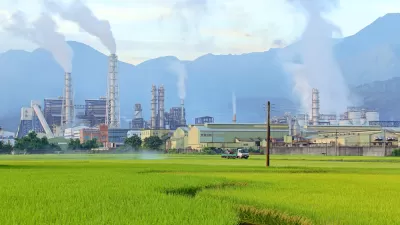An op-ed by Jostein Solheim, CEO of Ben & Jerry's, supports the second phase of greenhouse gas emissions and fuel efficiency standards for medium- and heavy-duty engines and vehicles that would become effective 2018.
I'm not sure how widespread in the corporate world the attitude expressed by Solheim and Ben & Jerry's is toward reducing carbon emissions, which they refer to as climate justice, but it's nice to read it in any case. The new rule, proposed June 19, stems from President Obama's decision to make climate change a legacy of his administration through executive action and rule-making by Environmental Protection Agency (EPA) and the National Highway Traffic Safety Administration (NHTSA).
"As the planet gets warmer, we at Ben & Jerry’s want to be sure that our ice cream is produced with as few greenhouse gas emissions as possible, to keep our fans supplied with Cherry Garcia without making climate change even worse," writes Jostein Solheim
We’ve done our homework and know that 17% of our carbon footprint comes from transportation, from shipping our ice cream from the factory to our distribution centers.
Heavy over-the-road trucks move 70% of America’s freight, yet these trucks average only six miles per gallon, are the fastest-growing single source of carbon pollution in the US, and truck travel is projected to increase 40% by 2040 [EIA: Annual Energy Outlook 2014 (PDF)].
More corporate support
Indra K. Nooyi, Chairman and Chief Executive Officer, PepsiCo, with Fred Krupp, President of the Environmental Defense Fund.
The Phase Two rule will apply to trucks built from 2019 to 2027, and will be finalized next year. Phase One rules [PDF] adopted in August 2011 applied to vehicles built for the 2014 to 2018 model years.
Hat tip: Jesse Prentice-Dunn, representative for the Sierra Club's Responsible Trade Program.
Correspondent's note: While it's great to see increased fuel efficiency and reduced greenhouse gas emissions, it would be even better to see advocates also mention the need to increase fuel taxes to compensate for reduced transportation revenue from "driving further on a gallon of gas or diesel."
FULL STORY: I scream, you scream, we all scream - for higher fuel emission standards

Alabama: Trump Terminates Settlements for Black Communities Harmed By Raw Sewage
Trump deemed the landmark civil rights agreement “illegal DEI and environmental justice policy.”

Study: Maui’s Plan to Convert Vacation Rentals to Long-Term Housing Could Cause Nearly $1 Billion Economic Loss
The plan would reduce visitor accommodation by 25% resulting in 1,900 jobs lost.

Why Should We Subsidize Public Transportation?
Many public transit agencies face financial stress due to rising costs, declining fare revenue, and declining subsidies. Transit advocates must provide a strong business case for increasing public transit funding.

Paris Bike Boom Leads to Steep Drop in Air Pollution
The French city’s air quality has improved dramatically in the past 20 years, coinciding with a growth in cycling.

Why Housing Costs More to Build in California Than in Texas
Hard costs like labor and materials combined with ‘soft’ costs such as permitting make building in the San Francisco Bay Area almost three times as costly as in Texas cities.

San Diego County Sees a Rise in Urban Coyotes
San Diego County experiences a rise in urban coyotes, as sightings become prevalent throughout its urban neighbourhoods and surrounding areas.
Urban Design for Planners 1: Software Tools
This six-course series explores essential urban design concepts using open source software and equips planners with the tools they need to participate fully in the urban design process.
Planning for Universal Design
Learn the tools for implementing Universal Design in planning regulations.
Smith Gee Studio
Alamo Area Metropolitan Planning Organization
City of Santa Clarita
Institute for Housing and Urban Development Studies (IHS)
City of Grandview
Harvard GSD Executive Education
Toledo-Lucas County Plan Commissions
Salt Lake City
NYU Wagner Graduate School of Public Service




























